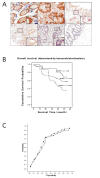Expression of CIAPIN1 in human colorectal cancer and its correlation with prognosis
- PMID: 20815902
- PMCID: PMC2944177
- DOI: 10.1186/1471-2407-10-477
Expression of CIAPIN1 in human colorectal cancer and its correlation with prognosis
Abstract
Background: The cytokine-induced anti-apoptotic molecule (CIAPIN1) had been found to be a differentially-expressed gene involved in a variety of cancers, and it was also considered as a candidate tumour suppressor gene in gastric cancer, renal cancer and liver cancer. However, studies on the role of CIAPIN1 in colorectal cancer were still unavailable. The aim of this study was to determine the prognostic impact of CIAPIN1 in 273 colorectal cancer (CRC) samples and to investigate the CIAPIN1 expression in CRC cell lines after inducing differentiation.
Methods: Immunohistochemical analysis was performed to detect the expression of CIAPIN1 in CRC samples from 273 patients. The relationship between CIAPIN1 expression and patients' characteristics (gender, age, location of cancer, UICC stage, local recurrence and tumour grade factors) was evaluated. In addition, these patients were followed up for five consecutive years to investigate the relationship between CIAPIN1 expression and the prognosis of CRC. We induced the differentiation of the CRC cell lines HT29 and SW480, in order to detect the expression of CIAPIN1 in the process of CRC cells differentiation.
Results: Results indicated that CIAPIN1 was mainly expressed in the cytoplasm and nucleus, and that its expression level in cancer samples was significantly lower than in normal tissues. The Wilcoxon-Mann-Whitney test showed a significant difference in the differential expression of CIAPIN1 in patients with different T and UICC stages, and tumour grade (P = 0.0393, 0.0297 and 0.0397, respectively). The Kaplan-Meier survival analysis demonstrated that the survival time of CRC patients with high expression of CIAPIN1 was longer than those with low expression during the 5-year follow up period (P = 0.0002). COX regression analysis indicated that low expression of CIAPIN1, cancer stage of > pT1, distant organ metastasis (pM1), regional lymph node metastasis (> pN1) and local recurrence (yes) were independent, poor prognostic factors of CRC (P = 0.012, P = 0.032, P <0.001, P <0.001, P <0.001 respectively). Both Western blotting and RT-PCR showed that CIAPIN1 expression was increased with the degree of differentiation of HT29 and SW480 cells.
Conclusions: CIAPIN1 played an important role in the differentiation of CRC cells, and the differential expression of CIAPIN1 in CRC was closely related to prognosis.
Figures



Similar articles
-
High KLF4 level in normal tissue predicts poor survival in colorectal cancer patients.World J Surg Oncol. 2014 Jul 24;12:232. doi: 10.1186/1477-7819-12-232. World J Surg Oncol. 2014. PMID: 25060774 Free PMC article.
-
Expression and significance of the Wip1 proto-oncogene in colorectal cancer.Asian Pac J Cancer Prev. 2013;14(3):1975-9. doi: 10.7314/apjcp.2013.14.3.1975. Asian Pac J Cancer Prev. 2013. PMID: 23679302
-
Correlation between mitochondrial TRAP-1 expression and lymph node metastasis in colorectal cancer.World J Gastroenterol. 2012 Nov 7;18(41):5965-71. doi: 10.3748/wjg.v18.i41.5965. World J Gastroenterol. 2012. PMID: 23139614 Free PMC article.
-
Association between the overexpression of Her3 and clinical pathology and prognosis of colorectal cancer: A meta-analysis.Medicine (Baltimore). 2018 Sep;97(37):e12317. doi: 10.1097/MD.0000000000012317. Medicine (Baltimore). 2018. PMID: 30212974 Free PMC article. Review.
-
Prognostic and clinicopathological value of FoxM1 expression in colorectal cancer: A systematic review and meta-analysis.Medicine (Baltimore). 2018 Dec;97(52):e13899. doi: 10.1097/MD.0000000000013899. Medicine (Baltimore). 2018. PMID: 30593202 Free PMC article.
Cited by
-
Downregulation of CIAPIN1 regulates the proliferation, migration and glycolysis of breast cancer cells via inhibition of STAT3 pathway.Sci Rep. 2024 Sep 5;14(1):20794. doi: 10.1038/s41598-024-71405-3. Sci Rep. 2024. PMID: 39242716 Free PMC article.
-
Identification of a Combined RNA Prognostic Signature in Adenocarcinoma of the Lung.Med Sci Monit. 2019 May 27;25:3941-3956. doi: 10.12659/MSM.913727. Med Sci Monit. 2019. PMID: 31132294 Free PMC article.
-
Secretome Analysis of Skeletal Myogenesis Using SILAC and Shotgun Proteomics.Int J Proteomics. 2011;2011:329467. doi: 10.1155/2011/329467. Epub 2011 Mar 29. Int J Proteomics. 2011. PMID: 22084683 Free PMC article.
-
ING4 enhances paclitaxel's effect on colorectal cancer growth in vitro and in vivo.Int J Clin Exp Pathol. 2015 Mar 1;8(3):2919-27. eCollection 2015. Int J Clin Exp Pathol. 2015. PMID: 26045800 Free PMC article.
-
Anti-Cancerous Potential of Polysaccharides Derived from Wheat Cell Culture.Pharmaceutics. 2022 May 20;14(5):1100. doi: 10.3390/pharmaceutics14051100. Pharmaceutics. 2022. PMID: 35631686 Free PMC article.
References
Publication types
MeSH terms
Substances
LinkOut - more resources
Full Text Sources
Medical
Miscellaneous

